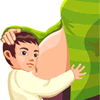Pregnancy and Infant Chiropractor Jacksonville
 Pregnancy Care:
Pregnancy Care:
During pregnancy , weight-bearing changes occur. This can cause an added stress to the spine. Chiropractic care during pregnancy not only can help you to stay more comfortable, but can also help to facilitate your birth.
Chiropractic care during pregnancy has been shown to significantly reduce the length of time a woman labors. First time moms averaged a 24 percent shorter labor, while mothers who have already given birth experienced a 39 percent reduction in the average labor length, compared to controls (Fallon, 1991). Chiropractic adjustments during pregnancy can also reduce the likelihood of experiencing back labor (Diakow, 1991). Regular chiropractic adjustments can safely continue up until the time of birth (Penna, 1989).
Infant and Child Care:
A young spine, with few exceptions, usually develops perfectly by the end of pregnancy. It’s what happens around the time of birth and in the months thereafter which can sometimes upset the normal functioning of the spine. Spinal segments can be pushed out of place or jammed by the position of the baby in the womb, or can suffer similar problems during labor from the trauma of the trip through the birth canal, or from the birthing process itself. Medical research has identified the fact that many problems early in a child’s life can come from birth trauma (See “‘KISS’ Syndrome” in Dynamic Chiropractic, 6/3/94).
Spinal problems can also occur as a result of the frequent falls suffered by young infants in the first months of life. A fall from a bed, a sudden stop in an automobile, or any significant unsupported movement of the head and neck in an infant can induce excessive movement in the spine causing vertebral subluxations. At the other end of the spine, the act of learning to walk, and the number of simple falls encountered in this way, can induce trauma to the lower spinal segments and to the large sacroiliac joints of the pelvis. Young children learning to walk also fall and hit their heads. These apparently innocent, frequently occurring events can also create spinal subluxations.
How Can Parents Recognize Childhood Spinal Problems?
Unless a child has an obvious problem, it can be difficult for parents to recognize when a child has spinal subluxations. It is not always easy for someone other than a chiropractor, highly trained in evaluating the spine, to determine if the child has a problem, just as it is difficult for someone other than a dentist to determine if a child has any cavities. Both cases take the skills of a trained specialist to perform a thorough evaluation.
There are some signs however which parents may look for which can be an indicator of a child with a spinal problem. Common indicators of spinal problems may include the child’s head consistently being tilted to one side; restricted head or neck motion to one side; disturbed sleeping patterns where the child sleeps for only an hour or two at a time; feeding difficulties in the very young infant; the infant may have difficulty nursing at the breast on one particular side.
Common childhood disorders can also sometimes indicate a spinal problem. Persistent earaches, sore throats, colic, headaches, bed-wetting, and growing pains are but some of the more common problems for which parents bring their children to the chiropractor.


















